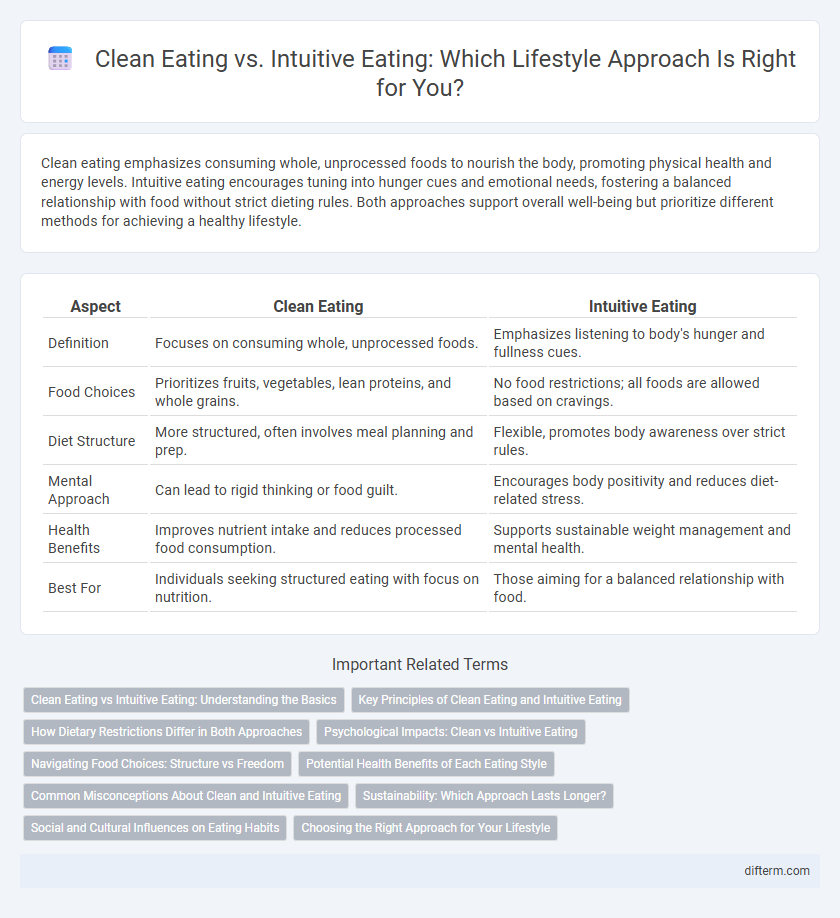Clean eating emphasizes consuming whole, unprocessed foods to nourish the body, promoting physical health and energy levels. Intuitive eating encourages tuning into hunger cues and emotional needs, fostering a balanced relationship with food without strict dieting rules. Both approaches support overall well-being but prioritize different methods for achieving a healthy lifestyle.
Table of Comparison
| Aspect | Clean Eating | Intuitive Eating |
|---|---|---|
| Definition | Focuses on consuming whole, unprocessed foods. | Emphasizes listening to body's hunger and fullness cues. |
| Food Choices | Prioritizes fruits, vegetables, lean proteins, and whole grains. | No food restrictions; all foods are allowed based on cravings. |
| Diet Structure | More structured, often involves meal planning and prep. | Flexible, promotes body awareness over strict rules. |
| Mental Approach | Can lead to rigid thinking or food guilt. | Encourages body positivity and reduces diet-related stress. |
| Health Benefits | Improves nutrient intake and reduces processed food consumption. | Supports sustainable weight management and mental health. |
| Best For | Individuals seeking structured eating with focus on nutrition. | Those aiming for a balanced relationship with food. |
Clean Eating vs Intuitive Eating: Understanding the Basics
Clean eating emphasizes consuming whole, minimally processed foods such as fruits, vegetables, lean proteins, and whole grains to promote optimal health. Intuitive eating focuses on tuning into internal hunger and fullness cues to create a balanced relationship with food, avoiding restrictive dieting patterns. Understanding the basics of clean eating versus intuitive eating helps individuals choose a sustainable approach tailored to their lifestyle and wellness goals.
Key Principles of Clean Eating and Intuitive Eating
Clean eating emphasizes consuming whole, minimally processed foods, prioritizing fresh fruits, vegetables, lean proteins, and whole grains while avoiding artificial additives and refined sugars. Intuitive eating centers on recognizing internal hunger cues, rejecting diet mentality, and fostering a healthy relationship with food by encouraging mindful, non-judgmental eating habits. Both approaches promote health but differ as clean eating follows structured food choices while intuitive eating relies on body awareness and emotional well-being.
How Dietary Restrictions Differ in Both Approaches
Clean eating emphasizes specific dietary restrictions by focusing on whole, unprocessed foods and often eliminates added sugars, artificial ingredients, and refined grains. Intuitive eating removes rigid dietary rules, encouraging individuals to listen to their body's hunger and fullness cues rather than following strict limitations. This fundamental difference highlights clean eating's structured approach versus intuitive eating's flexible, body-centered philosophy.
Psychological Impacts: Clean vs Intuitive Eating
Clean eating emphasizes strict rules and food purity, which can lead to increased stress, guilt, and anxiety around food choices. Intuitive eating promotes listening to bodily hunger cues and rejecting diet culture, fostering a healthier relationship with food and reducing psychological distress. Research indicates that intuitive eating correlates with improved self-esteem and lower rates of disordered eating compared to clean eating approaches.
Navigating Food Choices: Structure vs Freedom
Clean eating emphasizes structured food choices, prioritizing whole, unprocessed ingredients and consistent meal planning to promote health and nutrition. Intuitive eating encourages freedom by listening to internal hunger cues and cravings, fostering a balanced relationship with food without strict rules. Navigating food choices involves balancing the discipline of clean eating with the flexibility of intuitive eating to create a sustainable, personalized lifestyle.
Potential Health Benefits of Each Eating Style
Clean eating emphasizes whole, minimally processed foods rich in nutrients, potentially enhancing energy levels, supporting weight management, and reducing risks of chronic diseases such as diabetes and heart conditions. Intuitive eating fosters body awareness and emotional balance, promoting improved mental health, reduced disordered eating patterns, and sustainable, personalized nutrition habits. Both approaches encourage mindful food choices that can contribute to overall well-being and long-term health maintenance.
Common Misconceptions About Clean and Intuitive Eating
Common misconceptions about clean eating often include the belief that it requires strict calorie-counting and elimination of entire food groups, whereas intuitive eating emphasizes listening to one's body's hunger cues without rigid restrictions. Many assume intuitive eating leads to unhealthy choices, but it actually fosters a balanced relationship with food by encouraging mindful eating and self-compassion. Both approaches aim to improve overall wellness but focus on different methods--clean eating prioritizes whole, minimally processed foods, while intuitive eating promotes flexibility and attunement to internal signals.
Sustainability: Which Approach Lasts Longer?
Clean eating emphasizes consumption of whole, minimally processed foods, promoting nutrient density and environmental benefits through reduced reliance on processed products. Intuitive eating fosters a sustainable relationship with food by encouraging body awareness and mental well-being, reducing the risk of restrictive dieting and long-term relapse. Sustainability in lifestyle choices often favors intuitive eating for its adaptability and psychological balance, while clean eating supports environmental sustainability through conscious food selection.
Social and Cultural Influences on Eating Habits
Social and cultural influences significantly shape clean eating and intuitive eating practices by dictating food choices, portion sizes, and meal timing based on traditions and social norms. Clean eating is often promoted within communities valuing health-conscious, nutrient-dense diets, while intuitive eating aligns with cultures encouraging body awareness and emotional connection to food. Peer pressure, media portrayal, and family habits further impact adherence to either approach, highlighting the dynamic relationship between societal context and individual eating behaviors.
Choosing the Right Approach for Your Lifestyle
Clean eating emphasizes consuming whole, minimally processed foods to improve nutrition and energy levels, while intuitive eating encourages listening to your body's hunger and fullness cues to foster a healthier relationship with food. Selecting the right approach depends on individual lifestyle factors such as daily routine, stress levels, and personal health goals. Integrating elements from both methods can create a balanced strategy that supports sustainable wellbeing and mindful nourishment.
clean eating vs intuitive eating Infographic

 difterm.com
difterm.com